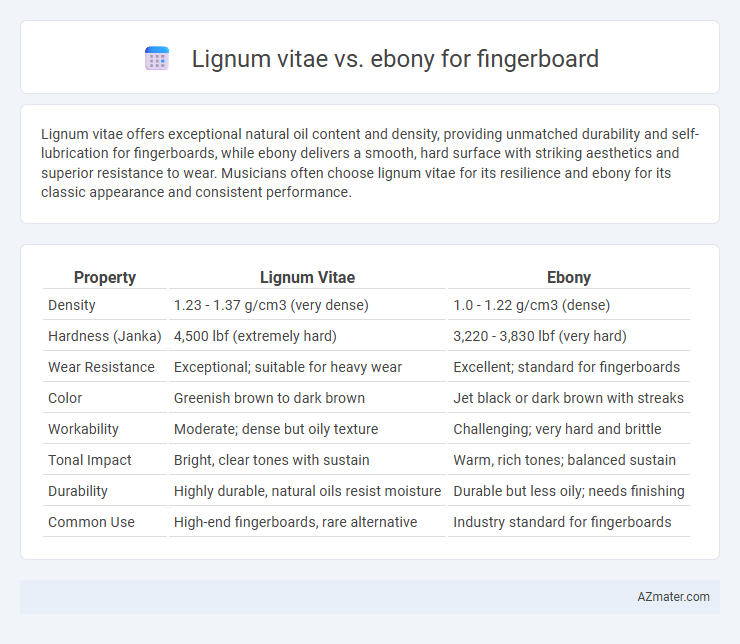Lignum vitae offers exceptional natural oil content and density, providing unmatched durability and self-lubrication for fingerboards, while ebony delivers a smooth, hard surface with striking aesthetics and superior resistance to wear. Musicians often choose lignum vitae for its resilience and ebony for its classic appearance and consistent performance.
Table of Comparison
| Property | Lignum Vitae | Ebony |
|---|---|---|
| Density | 1.23 - 1.37 g/cm3 (very dense) | 1.0 - 1.22 g/cm3 (dense) |
| Hardness (Janka) | 4,500 lbf (extremely hard) | 3,220 - 3,830 lbf (very hard) |
| Wear Resistance | Exceptional; suitable for heavy wear | Excellent; standard for fingerboards |
| Color | Greenish brown to dark brown | Jet black or dark brown with streaks |
| Workability | Moderate; dense but oily texture | Challenging; very hard and brittle |
| Tonal Impact | Bright, clear tones with sustain | Warm, rich tones; balanced sustain |
| Durability | Highly durable, natural oils resist moisture | Durable but less oily; needs finishing |
| Common Use | High-end fingerboards, rare alternative | Industry standard for fingerboards |
Introduction to Lignum Vitae and Ebony Fingerboards
Lignum vitae and ebony are both premium hardwoods prized for fingerboards due to their density, hardness, and smooth texture, enhancing playability and durability. Lignum vitae features natural oils that provide excellent self-lubrication and resistance to wear, commonly used in vintage and high-end instruments. Ebony, known for its deep black color and fine grain, offers superior stability and a sleek, polished finish favored in modern and classical stringed instruments.
Botanical Origins and Color Characteristics
Lignum vitae, derived from Guaiacum officinale and Guaiacum sanctum trees native to the Caribbean and northern South America, boasts a rich, dark green to brown hue with streaks of yellow and black, offering unique visual depth. Ebony, primarily sourced from Diospyros species native to India, Sri Lanka, and Africa, is prized for its dense, smooth texture and strikingly uniform jet-black color, often with subtle dark brown or gray undertones. Both woods are favored for fingerboards due to their hardness and natural oils, but their distinct botanical origins influence their color patterns and tactile qualities.
Density and Hardness Comparison
Lignum vitae boasts a density of approximately 1.23 g/cm3, making it one of the heaviest and hardest woods, exceeding ebony's density which ranges from 1.12 to 1.15 g/cm3. On the Janka hardness scale, lignum vitae scores around 4,500 lbf, indicating exceptional durability, while ebony typically measures between 3,200 and 3,800 lbf. The superior density and hardness of lignum vitae contribute to increased wear resistance and a more robust fingerboard surface compared to ebony.
Acoustic Properties and Tonal Differences
Lignum vitae fingerboards offer exceptional density and natural oils, resulting in a smooth playing surface that enhances sustain and provides warm, rounded tones with rich midrange frequencies. Ebony, being a dense and hard wood, delivers bright, crisp articulation and strong attack, emphasizing clarity and a balanced tonal spectrum ideal for intricate playing styles. The acoustic properties of Lignum vitae contribute to a unique vintage warmth, while ebony's tonal characteristics favor precision and definition.
Durability and Wear Resistance
Lignum vitae is renowned for its exceptional density and natural oils, making it highly durable and resistant to wear, ideal for fingerboards exposed to frequent playing and humidity. Ebony offers a smooth surface with excellent hardness and toughness, providing superior wear resistance and maintaining tonal clarity over time. Both woods excel in durability, but lignum vitae's self-lubricating properties often give it an edge in longevity and performance under intense use.
Workability and Maintenance
Lignum vitae offers exceptional density and natural oils, making it highly resistant to wear and reducing the need for frequent maintenance on fingerboards. Ebony provides a smooth, hard surface that is easier to shape and finish, but it requires regular conditioning to prevent drying and cracking. Workability favors ebony due to its uniform texture, while lignum vitae excels in durability and low maintenance for long-term performance.
Sustainability and Environmental Impact
Lignum vitae, known for its extreme density and natural oils, offers a sustainable choice for fingerboards due to its slow growth and relative abundance compared to ebony, which faces significant deforestation pressures and slower regeneration rates. Ebony's harvesting often leads to habitat loss and biodiversity decline, while sustainable sourcing certifications for lignum vitae help mitigate environmental damage. Opting for responsibly sourced lignum vitae reduces ecological footprints and supports forest conservation efforts more effectively than traditional ebony fingerboards.
Price and Availability
Lignum vitae is significantly rarer and more expensive than ebony due to its limited supply and slow growth rate, making it a premium choice for fingerboards. Ebony is more readily available and affordable, sourced primarily from African and Southeast Asian forests, though high-grade ebony can still command a substantial price. Both woods offer exceptional hardness and durability, but the cost and accessibility of ebony make it a more practical option for many musicians.
Player Preferences and Popular Applications
Lignum vitae offers exceptional density and natural oiliness, providing smooth playability and durability favored by bass and jazz guitar players for fingerboards. Ebony, prized for its hardness and bright tonal response, is commonly preferred by classical and electric guitarists seeking precise articulation and fast finger movement. Player preferences often hinge on tactile feel and tonal characteristics, with Lignum vitae delivering warmth and resilience, while ebony emphasizes clarity and crisp attack.
Conclusion: Choosing the Right Fingerboard Wood
Lignum vitae offers exceptional density, natural oils for lubrication, and superior durability, making it ideal for fingerboards that require longevity and smooth playability. Ebony is favored for its fine grain, hardness, and sleek aesthetics, contributing to precise note articulation and a classic appearance. Choosing the right fingerboard wood depends on balancing durability, tactile feel, and tonal qualities to suit the player's style and instrument type.

Infographic: Lignum vitae vs Ebony for Fingerboard
 azmater.com
azmater.com